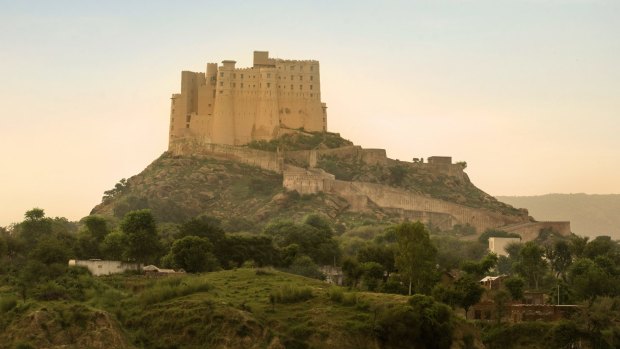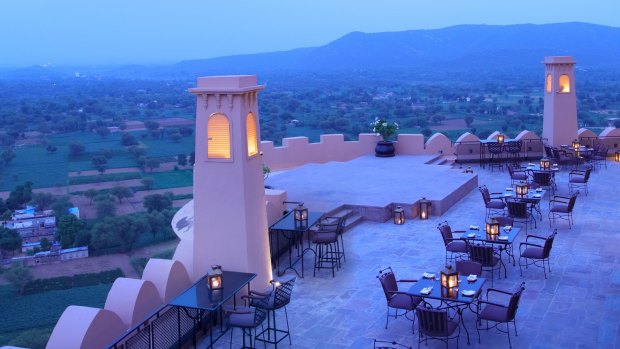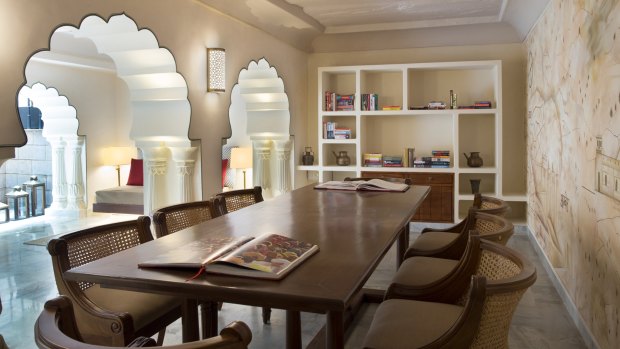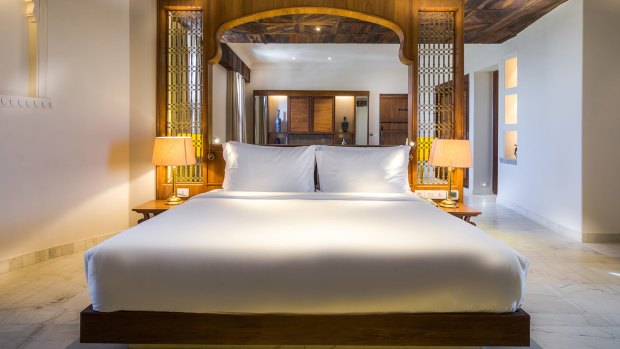This was published 5 years ago
Inside Alila Fort Bishangarh hotel, India: How a warrior fortress transformed into a luxury hotel

Alila Fort Bishangarh is a shining example of the heritage hotels that have been re-created from the artefacts of India's flamboyant past.Credit: Alila Hotels
"Was this the dungeon?" I just asked my masseuse. Fair question too, because I'm deep in the bowels of Alila Fort Bishangarh, and any fort worthy of the name must have a dungeon. "No," she says, and then pauses. She's not sure. But she promises not to make me scream.
So – screaming out, but there's plenty about the freshly minted Alila Fort Bishangarh that brings a sigh to the lips. A stylish amalgam of history and sophistication, Alila Fort Bishangarh is a shining example of the heritage hotels that have been re-created from the artefacts of India's flamboyant past, and nowhere more so than in the desert state of Rajasthan.
Repurposing an 18th century warrior fort into a cruisy hotel befitting the Alila label was a challenge. Set on a granite hilltop in the Aravalli Hills north of Jaipur, Fort Bishangarh was built late in the 1700s. It was a time of trouble. The Mughal empire was disintegrating, and the Rajput rulers of Rajasthan were metaphorically circling the wagons. The walls, three metres thick in parts, were designed to withstand cannonballs, war elephants and siege engines. Where they existed, windows were tiny.

The building's walls, three metres thick in parts, were designed to withstand cannonballs, war elephants and siege engines.
When Atul Kapur, one of the fort's three owners, began looking for architects and designers to remodel the fort in 2007, just getting inside involved a combination of rock climbing and caving. The interior, long since abandoned, had been colonised by an army of monkeys and squadrons of bats. Heavy lifting for the initial construction stages was done by a team of 30 mules. Nothing else would make it up the rocky path that zig-zagged up the hillside.
Almost 10 years later Alila Fort Bishangarh opened to universal applause from the arbiters of hotel excellence, possibly the most statuesque addition to the growing list of India's heritage hotels.
The meet-and-greet functions of the hotel take place in an open-sided pavilion below the fort. Behind is a haveli, a traditional mansion, with an open courtyard as its centrepiece and a fitness centre and a cafe overlooking an infinity pool. Transport up the Z-shaped ramp to the fort is by jeep, although the walk takes barely five minutes, with pretty green parrots that perch on the battlements for company.

The hotel library.
Rather than the florid style into which India's heritage hotels so often lapse, clean lines and minimalism are the order of the day. Corridors are stark and on the lower floors the rock of the hillside intrudes massively into the interiors.
The hotel incorporates many of the classical elements of Indo-Saracenic architecture, such as the jharokha-style enclosed balconies that project from the exterior of the building, allowing the women of the royal household to see without being seen, since purdah was a custom the Rajput rulers borrowed from their Mughal overlords.
There are cusped arches in the atrium and intricate jaali screens that spill geometric patterns across the marble floors when sunlight hits them. Exterior Walls are rendered with surkhi, stone dust, interiors with araish, a traditional wall finish made that uses slaked lime, marble dust, curd and jaggery, boiled sugar syrup. At the centre of the fort a hollow atrium open to the sky brings light into the interior of the building.

A Grand Royal Heritage suite.
Even the best efforts of clever architects and engineers were unable to tame the dimensions of the old fort and no two of the 59 guest suites are the same. Common to all are marble floors, vast bathrooms with tubs as well as walk-in rain showers, day beds, big windows that overlook the patchwork of fields on the plain below and dimensions fitting for a palace.
Heritage rooms, the lowest category, are a whopping 52 square metres. Regal suites take that up to 85 square metres, with an in-room jacuzzi, although the rough wood panelling on the ceiling strikes a curiously agricultural note.
Surrounding the fort, the village of Bishangarh charms, and Alila has wisely harnessed the warp and weft of its everyday life – everyday to the villagers, revelatory to us – to offer guests a window on village India. A stroll through the village takes you past old havelis, temples and a jewellers shop, with the occasional browsing cow that is never far from the background in India.
In the front room of her house a woman threads carpets by hand on a loom. It's a technique that hasn't changed in centuries, although on the day I visited her teenage daughter was busy in the background on her laptop.
Lunch is served in the courtyard of a village house – dahl, vegetables, chapatis, curd and rice, and if you'd like to try your hand at chapati making over an open fire, best of luck. Country horse rides on pixie-eared Marwari horses, rural bike rides, hiking in the Aravalli Hills, dairy visits and the spa give you plenty of reasons for a three-night stay.
While it's only a little over a one-hour drive north of Jaipur, Bishangarh is not an ideal base from which to take in the marvels of the Pink City. Getting into the heart of Jaipur, where the attractions include the City Palace and the Hawa Mahal, Palace of the Winds, involves a tortuous journey through horrendous, honking traffic, it's crowded and jostly and anything more than a half-day and you'll be over it.
You're better off basing yourself in Jaipur for a couple of days, ticking off the highlights and shopping for the bling for which the city is famous and then transferring to Bishangarh and anchoring yourself to take advantage of the five-star relaxation that is the fort's forte.
Vegetables for the fort's restaurants come from its own organic garden while other ingredients are locally sourced as far as possible. Dining options include the Mediterranean influenced poolside cafe but the standout is dinner outside on the high terrace at Nazaara. It's a set four-course menu, either veg or non-veg, with both a spit roast and sandpit cooking, a traditional slow-food technique in the desert state of Rajasthan. Nazaara is pure magic in the evening. Bells and chanting voices drift up from the temples below, dust from the hoofs of homeward-bound cattle casts the village into soft focus, and India delivers a very special moment.
The other dining option in the fort is the glossy Amarsar, which takes its cues from the cuisine of the Silk Route, at least the bit from Mongolia to the shores of the Mediterranean. Amarsar sits beside the atrium and one morning there's a flute player in the hollow at the bottom, the crystal notes amplified by the walls as they rise skyward. The angels must be sighing too.
TRIP NOTES
FLY
Air India has non-stop flights from Melbourne and Sydney to Delhi, however Singapore Airlines' one-stop service via Singapore is preferable. From Delhi's Indira Gandhi International Airport, Alila Fort Bishangarh is a 3½ hour drive. Jaipur's Airport is a one-hour drive.
STAY
The double room rate at Alila Fort Bishangarh starts at about $280 a night in low season. Bookings made via the hotel's website bring extra benefits, including lower rates.
MORE
Michael Gebicki travelled at his own expense
Sign up for the Traveller Deals newsletter
Get exclusive travel deals delivered straight to your inbox. Sign up now.